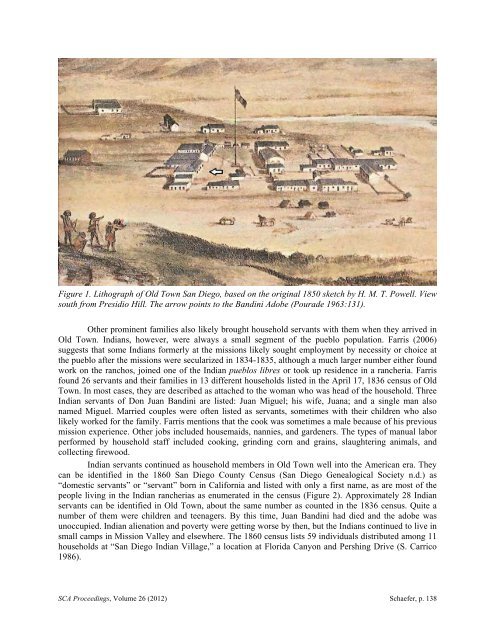Jerry Schaefer - Society for California Archaeology
Jerry Schaefer - Society for California Archaeology
Jerry Schaefer - Society for California Archaeology
Create successful ePaper yourself
Turn your PDF publications into a flip-book with our unique Google optimized e-Paper software.
Figure 1. Lithograph of Old Town San Diego, based on the original 1850 sketch by H. M. T. Powell. View<br />
south from Presidio Hill. The arrow points to the Bandini Adobe (Pourade 1963:131).<br />
Other prominent families also likely brought household servants with them when they arrived in<br />
Old Town. Indians, however, were always a small segment of the pueblo population. Farris (2006)<br />
suggests that some Indians <strong>for</strong>merly at the missions likely sought employment by necessity or choice at<br />
the pueblo after the missions were secularized in 1834-1835, although a much larger number either found<br />
work on the ranchos, joined one of the Indian pueblos libres or took up residence in a rancheria. Farris<br />
found 26 servants and their families in 13 different households listed in the April 17, 1836 census of Old<br />
Town. In most cases, they are described as attached to the woman who was head of the household. Three<br />
Indian servants of Don Juan Bandini are listed: Juan Miguel; his wife, Juana; and a single man also<br />
named Miguel. Married couples were often listed as servants, sometimes with their children who also<br />
likely worked <strong>for</strong> the family. Farris mentions that the cook was sometimes a male because of his previous<br />
mission experience. Other jobs included housemaids, nannies, and gardeners. The types of manual labor<br />
per<strong>for</strong>med by household staff included cooking, grinding corn and grains, slaughtering animals, and<br />
collecting firewood.<br />
Indian servants continued as household members in Old Town well into the American era. They<br />
can be identified in the 1860 San Diego County Census (San Diego Genealogical <strong>Society</strong> n.d.) as<br />
“domestic servants” or “servant” born in Cali<strong>for</strong>nia and listed with only a first name, as are most of the<br />
people living in the Indian rancherias as enumerated in the census (Figure 2). Approximately 28 Indian<br />
servants can be identified in Old Town, about the same number as counted in the 1836 census. Quite a<br />
number of them were children and teenagers. By this time, Juan Bandini had died and the adobe was<br />
unoccupied. Indian alienation and poverty were getting worse by then, but the Indians continued to live in<br />
small camps in Mission Valley and elsewhere. The 1860 census lists 59 individuals distributed among 11<br />
households at “San Diego Indian Village,” a location at Florida Canyon and Pershing Drive (S. Carrico<br />
1986).<br />
SCA Proceedings, Volume 26 (2012) <strong>Schaefer</strong>, p. 138
















